Survey of Father's Views on Childrearing in Japan I
Section 1 : Husband's views on wife's employment

Approximately 60% of the husbands surveyed would like their wives to quit work temporarily after childbirth. It seems that the higher a wife's annual income is, the more the husband supports her working. Husbands who do not have a strong sense of division of labor by gender role show higher approval of the wife's working, but do not necessarily agree with her continuing work after childbirth.

 64.1% of the wives are full-time homemakers
64.1% of the wives are full-time homemakers
In this section, we will discuss husbands' views on women and work as well as the degree to which they approve of the wife's working, after first examining the employment situation and annual income of wives.
Figure 3-1-1 represents the employment situation of the participants' wives. 64.1% of the wives are a full-time homemaker, 17.3% are a full-time worker, and 11.9% are a part-timer.
Depending on the age bracket of the children, the number of full-time homemakers seems to decrease and that of part-timers tends to increase as the children get older.
Regarding the wives' annual income, approximately 60% of the wives do not have an income. If any, 23.5%, or the majority of them, earn less than two million yen. 6.9% earn between two million and four million yen, 5.0% earn between four million and six million yen, and 2.3% earn six million yen or more.
In families with preschool children, few wives earn the same amount of income as their husbands. Approximately 60% of the families depend on the husband's income. Based on these facts, let's take a look at the husbands' views on the employment of their wives.
Figure 3-1-1: Employment Situation of Wives (Number of respondents: 2958)
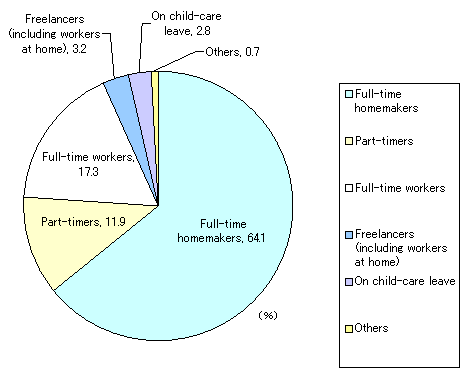
 Approximately 60% of the husbands would like their wives to quit work temporarily when their child is born
Approximately 60% of the husbands would like their wives to quit work temporarily when their child is born
What is the general perspective of the husbands on women having a job? Figure 3-1-4 represents the husbands' responses to seven choices concerning: women getting married and having children as well as women working.
63.4%, or the majority of the husbands, answered that they hope women will quit working temporarily when a child is born and go back to work after the child gets old enough. Although few answered that women should quit working after getting married, many husbands think that women should stay at home after giving birth. 21.7%, representing the second most popular response, think that women can continue working even after having children. Next, we will discuss the degree to which husbands approve of the wife's working.
Figure 3-1-4: Husbands' attitude toward women working (Number of respondents: 2958)
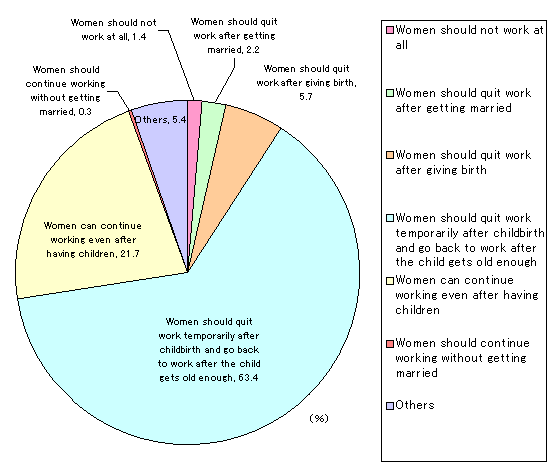
 30.9% of the husbands strongly approve and 53.8% somewhat approve of the wife having a job. If the wife's annual income is two million yen or more, more than half of the husbands approve of the wife's working.
30.9% of the husbands strongly approve and 53.8% somewhat approve of the wife having a job. If the wife's annual income is two million yen or more, more than half of the husbands approve of the wife's working.
Figure 3-1-5: Husbands' views on the wife working (Number of respondents: 2958)
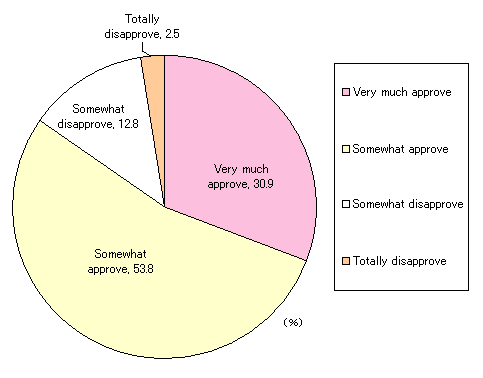
In Figure 3-1-5, husbands were asked what they thought about the wife's working and were given a choice of four responses ranging from "very much approve" to "do not approve at all." Almost half of the husbands answered that they are "somewhat approve" of the wife's working. Together with the husbands who "very much approve," more than 80% of the husbands support the wife's decision to work.
What factors are related to the degree to which husbands approve of the wife's working? Let's look at the aspect of family budget. The following is the trend in the relationship between wife's annual income and the degree of the husband's approval.
First, we need to remember that approximately 60% of the wives do not have an income. 55.7% of the husbands, whose wives' annual income is between two million yen and four million yen, and 64% of those whose wives earn between four million yen and six million yen "very much approve". The result implies that the degree to which husbands approve of the wife's decision to work is related to the impact on household income.
 The husbands who do not have a strong sense of division of labor by gender role approve more of the wife's working, but not necessarily approve of their continuing work after giving birth.
The husbands who do not have a strong sense of division of labor by gender role approve more of the wife's working, but not necessarily approve of their continuing work after giving birth.
Next, we will discuss the relationship between the husbands' sense of division of labor by gender role and the degree to which they approve of the wife's working. In this survey, the husbands were given a choice of four responses ranging from "strongly approve" to "strongly disapprove" to the statement "I firmly believe that men should work outside the home and women should run the household". The combined percentage of husbands who "strongly disapprove" and "somewhat disapprove" was 67.8%, so, in general, the husbands do not appear to have a strong sense of division of labor by gender role. (Figure 3-1-7)
Figure 3-1-7: I firmly believe that men should work outside and women should run the household. (Number of respondents: 2958)
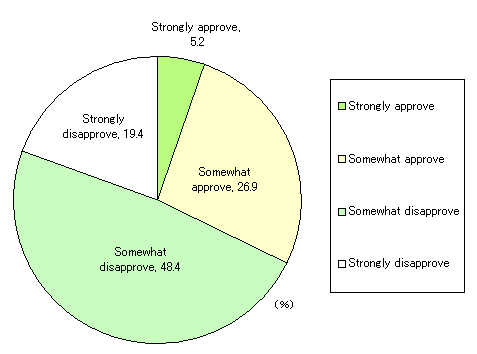
Regarding the relationship between the husbands' sense of division of labor by gender role and their attitudes toward women working, 41% of the husbands answered that women can continue working even after having children, while 45% of them noted that women should quit working temporarily after childbirth and go back to work after the child gets old enough. Even if a husband does not have a strong sense of division of labor by gender role and approves of his wife working, almost half of the husbands responded that women should quit work temporarily after childbirth and go back to work after the child gets old enough. The reason is not clear at this point, but the result may strongly reflect the husbands' perception that the work environment is too difficult for women to continue working after having children.
Section 2 : Child-care leave by husbands and desired child-care support

The Law Concerning the Promotion of Measures to Develop the Next Generation was established in 2003, and an increasing number of companies and local governments started working on child-care support. In this survey, 2.4% of the fathers have taken child-care leave. On the other hand, 23% of the fathers answered that they couldn't take child-care leave although they wanted to. The main reasons for their not being able to take child-care leave appear to be that they do not want to cause trouble to the company and they are too busy working. Many of the fathers mentioned that the legal system for the father-friendly child-care support, such as flexible work hours and mandatory child-care leave, needs to be improved.

 Husbands taking child-care leave
Husbands taking child-care leave
In this survey, 2.4% of the fathers have taken child-care leave (Figure 3-2-1). Among those who have not taken child-care leave, 74.6% of the fathers answered that they did not because they did not think of taking it. On the other hand, 23% of them mentioned that they couldn't take child-care leave although they wanted to. It implies that about 25% of the fathers would be likely to take child-care leave if the conditions were right.
Figure 3-2-1: Husbands taking child-care leave (Number of respondents: 2958)
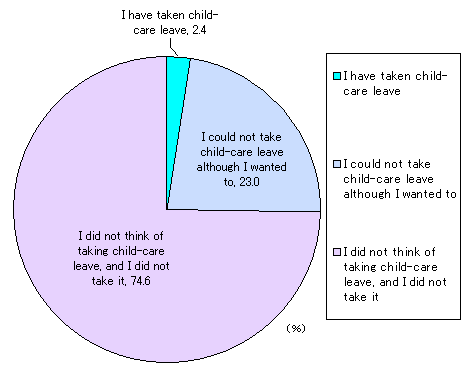
Then, why didn't the fathers take child-care leave? The survey asked their reasons for not taking child-care leave. The fathers chose up to three reasons out of 13 possible responses. The top two reasons concerned the impact on the workplace and being too busy. 31.2% of the fathers answered that they did not want to cause trouble to the company, and 31% said they were too busy to take child-care leave. The third most common answer was that there was a lack of precedent (24.5%). The fourth reason was financial. 19.4% of the fathers answered that they were reluctant to take the leave due to salary decrease. In addition, 18.9% answered that they did not think of taking child-care leave in any case (Figure 3-2-2).
Figure 3-2-2: Husbands' reasons for not taking child-care leave (Number of respondents: 2887)
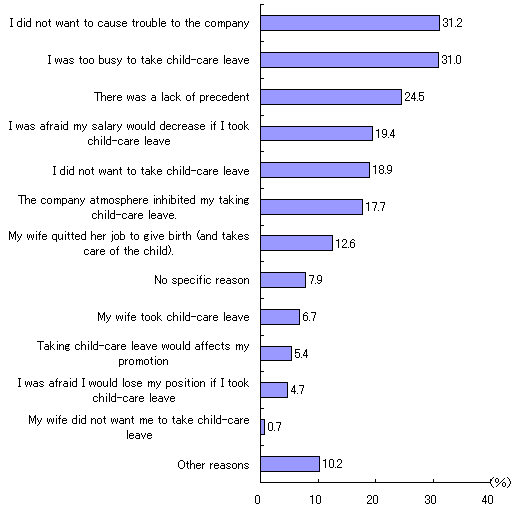
 The fathers who wanted to take child-care leave but couldn't because of the company atmosphere
The fathers who wanted to take child-care leave but couldn't because of the company atmosphere
As noted above, 23.0% of the fathers wanted to take child-care leave but couldn't. What kind of situation does this represent? What factors discourage them from taking child-care leave?
The main reasons for fathers not being able to take child-care leave although they wanted to were: they did not want to cause trouble to the company; they were too busy to take child-care leave; there was a lack of precedent; and the company atmosphere inhibited taking child-care leave. The result implies that company atmosphere is a strong disincentive for the fathers who want to take child-care leave, but don't.
Among those who couldn't take child-care leave although they wanted to, 35 out of 79 fathers chose "other reasons" and specifically stated that their company did not have a child-care support system. In addition, 11 of them answered that their wives were full-time homemakers. Under the current Law concerning the Welfare of Workers Who Take Care of Children or Other Family Members Including Child Care and Family Care Leave, when either spouse is a full-time homemaker or is capable of taking care of their children by taking child-care leave, etc.; the company can prohibit the other spouse from taking child-care leave if there is a labor-management agreement. Such a condition seems to be another disincentive for the fathers who couldn't take child-care leave although they wanted to.
Among the men who wanted to take child-care leave but couldn't, is it possible that some of them wanted to take child-care leave to lighten the burden of his full-time working wife? The survey shows that 27.7% of their wives work full-time and 21.2% are full-time homemakers. Although the rate of wives who work full-time was slightly higher than that of full-time homemakers, there was no significant difference in the percentage of husbands who took child-care leave. Even though a wife works full-time, she herself tends to take child-care leave; therefore, this does not entail a dramatic increase in the number of husbands who take child-care leave.
 Many of the husbands who did not think of taking child-care leave are either self-employed or have wives who are full-time homemakers
Many of the husbands who did not think of taking child-care leave are either self-employed or have wives who are full-time homemakers
As noted above, 74.6% of the fathers answered that they did not think of taking child-care leave. What are their reasons for not even considering this option?
The fathers who did not think of taking child-care leave and did not take it, stated that they were too busy to take child-care leave (28.1%), and they did not want to cause trouble to the company (27.8%). In addition, as many as 24.5% of them answered that they did not want to take child-care leave. Many fathers in this group had no intention of taking child-care leave. This is the major difference between this group of fathers and those who wanted to take child-care leave, but felt they couldn't.
In considering the correlation between child-care leave by the husband and the wife's employment situation, the survey shows that more husbands do not consider the option of taking child-care leave when the wife is a full-time homemaker or on leave from work.
Among the reasons employed husbands cite for not taking child-care leave are not wanting to cause trouble to the company and being too busy to take child-care leave. However, a self-employed husband does not have anyone else to work for him even if there is the child-care support system. Taking child-care leave will also directly affect income. Therefore, the reality for self-employed husbands is that they cannot even contemplate taking child-care leave.
 Father-friendly child-care support
Father-friendly child-care support
This survey has indicated that various obstacles prevent men from taking child-care leave. As such, what kind of child-care support is needed so that fathers can become more involved in childrearing? The survey asked fathers about the type of child-care support measures they would take advantage of. No restriction was placed on the number of possible responses. Those who chose "others" were asked to explain the nature of the desired child-care support.
Figure 3-2-6 represents the list of child-care support measures that the fathers would like to take advantage of. Many fathers chose policies that allow a flexible working style such as flexible or fewer work hours (54.6%); and telecommuting (45.1%). In addition, a considerable number would like to see improvements in the legal system for child-care support: 46.3% would like mandatory child-care leave, and 44.3% think that 100% of salary should be paid during child-care leave. Given that the harsh working environment was also a reason cited for not being able to take child-care leave by fathers wishing to do so, the survey indicates that many fathers feel that institutional support in the form of policies is necessary to encourage greater involvement of fathers in childrearing.
Figure 3-2-6: Child-care support desired by fathers (Number of respondents: 2958)
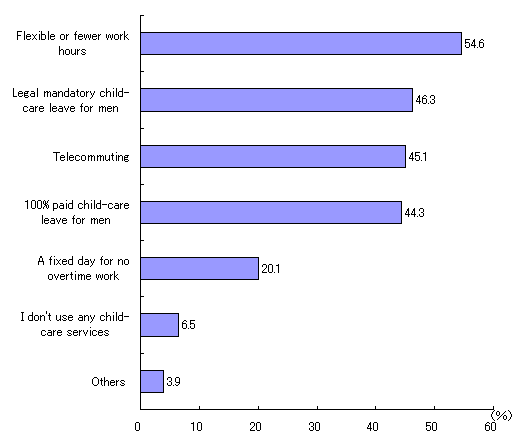
In addition to flexible work hours, other desired child-care support measures include financial assistance such as child-care allowance and preferential tax treatment (Figure 3-2-7). Moreover, many fathers want to see improved day-care services such as extension of child-care hours. They also want a more father-friendly atmosphere through greater awareness in the community and workplace of men taking child-care leave.
Figure 3-2-7: Child-care support desired by fathers (other specific requests) (Number of respondents: 113)
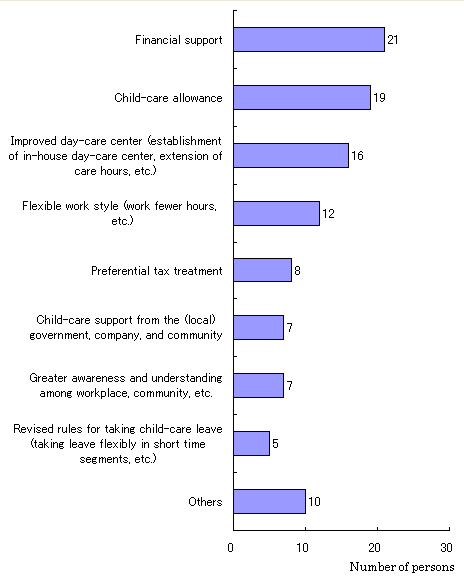
Based upon the above data, in order to achieve greater involvement of fathers in childrearing, child support measures in accordance with various employment formats need to be devised, along with promoting greater understanding, support, and awareness of participation by men in childrearing.
- Research Design Outline
- Chapter 1: The Relationship with Their Partners and Children (excerpt)
- Chapter 2: Fathers' Views on Child-rearing, Education and Family (excerpt)
- Chapter 3: Fathers Reconciling Work and Family (This article)
Section 1 : Husband's views on wife's employment
Approximately 60% of the husbands surveyed would like their wives to quit work temporarily after childbirth. It seems that the higher a wife's annual income is, the more the husband supports her working. Husbands who do not have a strong sense of division of labor by gender role show higher approval of the wife's working, but do not necessarily agree with her continuing work after childbirth.
In this section, we will discuss husbands' views on women and work as well as the degree to which they approve of the wife's working, after first examining the employment situation and annual income of wives.
Figure 3-1-1 represents the employment situation of the participants' wives. 64.1% of the wives are a full-time homemaker, 17.3% are a full-time worker, and 11.9% are a part-timer.
Depending on the age bracket of the children, the number of full-time homemakers seems to decrease and that of part-timers tends to increase as the children get older.
Regarding the wives' annual income, approximately 60% of the wives do not have an income. If any, 23.5%, or the majority of them, earn less than two million yen. 6.9% earn between two million and four million yen, 5.0% earn between four million and six million yen, and 2.3% earn six million yen or more.
In families with preschool children, few wives earn the same amount of income as their husbands. Approximately 60% of the families depend on the husband's income. Based on these facts, let's take a look at the husbands' views on the employment of their wives.
Figure 3-1-1: Employment Situation of Wives (Number of respondents: 2958)

What is the general perspective of the husbands on women having a job? Figure 3-1-4 represents the husbands' responses to seven choices concerning: women getting married and having children as well as women working.
63.4%, or the majority of the husbands, answered that they hope women will quit working temporarily when a child is born and go back to work after the child gets old enough. Although few answered that women should quit working after getting married, many husbands think that women should stay at home after giving birth. 21.7%, representing the second most popular response, think that women can continue working even after having children. Next, we will discuss the degree to which husbands approve of the wife's working.
Figure 3-1-4: Husbands' attitude toward women working (Number of respondents: 2958)

Figure 3-1-5: Husbands' views on the wife working (Number of respondents: 2958)

In Figure 3-1-5, husbands were asked what they thought about the wife's working and were given a choice of four responses ranging from "very much approve" to "do not approve at all." Almost half of the husbands answered that they are "somewhat approve" of the wife's working. Together with the husbands who "very much approve," more than 80% of the husbands support the wife's decision to work.
What factors are related to the degree to which husbands approve of the wife's working? Let's look at the aspect of family budget. The following is the trend in the relationship between wife's annual income and the degree of the husband's approval.
First, we need to remember that approximately 60% of the wives do not have an income. 55.7% of the husbands, whose wives' annual income is between two million yen and four million yen, and 64% of those whose wives earn between four million yen and six million yen "very much approve". The result implies that the degree to which husbands approve of the wife's decision to work is related to the impact on household income.
Next, we will discuss the relationship between the husbands' sense of division of labor by gender role and the degree to which they approve of the wife's working. In this survey, the husbands were given a choice of four responses ranging from "strongly approve" to "strongly disapprove" to the statement "I firmly believe that men should work outside the home and women should run the household". The combined percentage of husbands who "strongly disapprove" and "somewhat disapprove" was 67.8%, so, in general, the husbands do not appear to have a strong sense of division of labor by gender role. (Figure 3-1-7)
Figure 3-1-7: I firmly believe that men should work outside and women should run the household. (Number of respondents: 2958)

Regarding the relationship between the husbands' sense of division of labor by gender role and their attitudes toward women working, 41% of the husbands answered that women can continue working even after having children, while 45% of them noted that women should quit working temporarily after childbirth and go back to work after the child gets old enough. Even if a husband does not have a strong sense of division of labor by gender role and approves of his wife working, almost half of the husbands responded that women should quit work temporarily after childbirth and go back to work after the child gets old enough. The reason is not clear at this point, but the result may strongly reflect the husbands' perception that the work environment is too difficult for women to continue working after having children.
Section 2 : Child-care leave by husbands and desired child-care support
The Law Concerning the Promotion of Measures to Develop the Next Generation was established in 2003, and an increasing number of companies and local governments started working on child-care support. In this survey, 2.4% of the fathers have taken child-care leave. On the other hand, 23% of the fathers answered that they couldn't take child-care leave although they wanted to. The main reasons for their not being able to take child-care leave appear to be that they do not want to cause trouble to the company and they are too busy working. Many of the fathers mentioned that the legal system for the father-friendly child-care support, such as flexible work hours and mandatory child-care leave, needs to be improved.
In this survey, 2.4% of the fathers have taken child-care leave (Figure 3-2-1). Among those who have not taken child-care leave, 74.6% of the fathers answered that they did not because they did not think of taking it. On the other hand, 23% of them mentioned that they couldn't take child-care leave although they wanted to. It implies that about 25% of the fathers would be likely to take child-care leave if the conditions were right.
Figure 3-2-1: Husbands taking child-care leave (Number of respondents: 2958)

Then, why didn't the fathers take child-care leave? The survey asked their reasons for not taking child-care leave. The fathers chose up to three reasons out of 13 possible responses. The top two reasons concerned the impact on the workplace and being too busy. 31.2% of the fathers answered that they did not want to cause trouble to the company, and 31% said they were too busy to take child-care leave. The third most common answer was that there was a lack of precedent (24.5%). The fourth reason was financial. 19.4% of the fathers answered that they were reluctant to take the leave due to salary decrease. In addition, 18.9% answered that they did not think of taking child-care leave in any case (Figure 3-2-2).
Figure 3-2-2: Husbands' reasons for not taking child-care leave (Number of respondents: 2887)

Note: The respondents were allowed to choose up to three reasons
As noted above, 23.0% of the fathers wanted to take child-care leave but couldn't. What kind of situation does this represent? What factors discourage them from taking child-care leave?
The main reasons for fathers not being able to take child-care leave although they wanted to were: they did not want to cause trouble to the company; they were too busy to take child-care leave; there was a lack of precedent; and the company atmosphere inhibited taking child-care leave. The result implies that company atmosphere is a strong disincentive for the fathers who want to take child-care leave, but don't.
Among those who couldn't take child-care leave although they wanted to, 35 out of 79 fathers chose "other reasons" and specifically stated that their company did not have a child-care support system. In addition, 11 of them answered that their wives were full-time homemakers. Under the current Law concerning the Welfare of Workers Who Take Care of Children or Other Family Members Including Child Care and Family Care Leave, when either spouse is a full-time homemaker or is capable of taking care of their children by taking child-care leave, etc.; the company can prohibit the other spouse from taking child-care leave if there is a labor-management agreement. Such a condition seems to be another disincentive for the fathers who couldn't take child-care leave although they wanted to.
Among the men who wanted to take child-care leave but couldn't, is it possible that some of them wanted to take child-care leave to lighten the burden of his full-time working wife? The survey shows that 27.7% of their wives work full-time and 21.2% are full-time homemakers. Although the rate of wives who work full-time was slightly higher than that of full-time homemakers, there was no significant difference in the percentage of husbands who took child-care leave. Even though a wife works full-time, she herself tends to take child-care leave; therefore, this does not entail a dramatic increase in the number of husbands who take child-care leave.
As noted above, 74.6% of the fathers answered that they did not think of taking child-care leave. What are their reasons for not even considering this option?
The fathers who did not think of taking child-care leave and did not take it, stated that they were too busy to take child-care leave (28.1%), and they did not want to cause trouble to the company (27.8%). In addition, as many as 24.5% of them answered that they did not want to take child-care leave. Many fathers in this group had no intention of taking child-care leave. This is the major difference between this group of fathers and those who wanted to take child-care leave, but felt they couldn't.
In considering the correlation between child-care leave by the husband and the wife's employment situation, the survey shows that more husbands do not consider the option of taking child-care leave when the wife is a full-time homemaker or on leave from work.
Among the reasons employed husbands cite for not taking child-care leave are not wanting to cause trouble to the company and being too busy to take child-care leave. However, a self-employed husband does not have anyone else to work for him even if there is the child-care support system. Taking child-care leave will also directly affect income. Therefore, the reality for self-employed husbands is that they cannot even contemplate taking child-care leave.
This survey has indicated that various obstacles prevent men from taking child-care leave. As such, what kind of child-care support is needed so that fathers can become more involved in childrearing? The survey asked fathers about the type of child-care support measures they would take advantage of. No restriction was placed on the number of possible responses. Those who chose "others" were asked to explain the nature of the desired child-care support.
Figure 3-2-6 represents the list of child-care support measures that the fathers would like to take advantage of. Many fathers chose policies that allow a flexible working style such as flexible or fewer work hours (54.6%); and telecommuting (45.1%). In addition, a considerable number would like to see improvements in the legal system for child-care support: 46.3% would like mandatory child-care leave, and 44.3% think that 100% of salary should be paid during child-care leave. Given that the harsh working environment was also a reason cited for not being able to take child-care leave by fathers wishing to do so, the survey indicates that many fathers feel that institutional support in the form of policies is necessary to encourage greater involvement of fathers in childrearing.
Figure 3-2-6: Child-care support desired by fathers (Number of respondents: 2958)

Note: The respondents were allowed to choose more than one answer.
In addition to flexible work hours, other desired child-care support measures include financial assistance such as child-care allowance and preferential tax treatment (Figure 3-2-7). Moreover, many fathers want to see improved day-care services such as extension of child-care hours. They also want a more father-friendly atmosphere through greater awareness in the community and workplace of men taking child-care leave.
Figure 3-2-7: Child-care support desired by fathers (other specific requests) (Number of respondents: 113)

Based upon the above data, in order to achieve greater involvement of fathers in childrearing, child support measures in accordance with various employment formats need to be devised, along with promoting greater understanding, support, and awareness of participation by men in childrearing.














